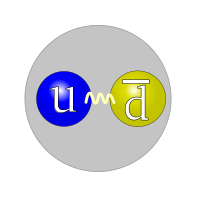
Photo from wikipedia
We aim to explore the production rate of the pseudoscalar glueball in $J/\psi$ radiative decay by lattice QCD in quenched approximation. The calculation is performed on three anisotropic lattices with… Click to show full abstract
We aim to explore the production rate of the pseudoscalar glueball in $J/\psi$ radiative decay by lattice QCD in quenched approximation. The calculation is performed on three anisotropic lattices with the spatial lattice spacing ranging from 0.222(2) fm to 0.110(1) fm. As a calibration of some systematical uncertainties, we first extract the $M1$ form factor $\hat{V}(0)$ of the process $J/\psi\to\gamma\eta_{c}$ and get the result $\hat{V}(0)=1.933(41)$ in the continuum limit, which gives the partial width $\Gamma(J/\psi\to\gamma\eta_{c})=2.47(11)$ keV. These results are in agreement with that of previous lattice studies. As for the pseudoscalar glueball $G_{0^{-+}}$, its mass is derived to be $2.395(14)$ GeV, and the form factor $\hat{V}(0)$ of the process $J/\psi\to\gamma G_{0^{-+}}$ is determined to be $\hat{V}(0)=0.0246(43)$ after continuum extrapolation. Finally, the production rate of the pseudoscalar glueball is predicted to be $2.31(90)\times10^{-4}$, which is much smaller than that of conventional light $q\bar{q}$ $\eta$ states. After the subtraction of the phase space factor, the couplings of $J/\psi X\gamma$ are similar where $X$ stands for $\eta$ states and the pseudoscalar glueball. Possibly, the $U_{A}(1)$ anomaly plays an important role for the large couplings of gluons to the flavor singlet $\eta$ states in $J/\psi$ radiative decays.
Journal Title: Physical Review D
Year Published: 2019
Link to full text (if available)
Share on Social Media: Sign Up to like & get
recommendations!